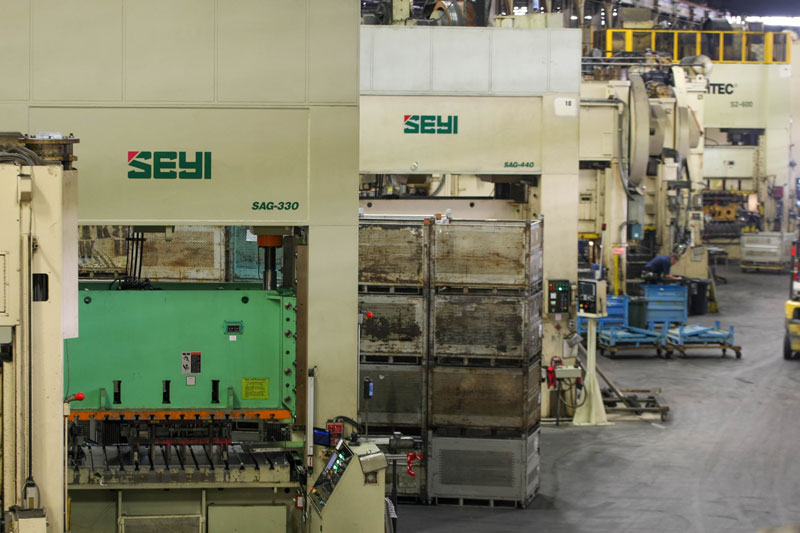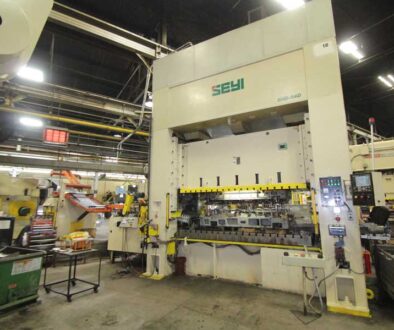Metal Stamping Presses 101 – An Overview of Press Types and Stamping Processes

There are numerous different types of metal stamping presses commonly used throughout today’s industrial manufacturing world. Likewise, there are many unique stamping operations which are optimized for different types of products or different metalworking features.
Below, we discuss some of the most common designs of metal stamping presses along with their advantages. We also compare the many different metal stamping processes and the typical product applications thereof.
The Common Types of Metal Stamping Presses Compared
Mechanical Stamping Presses
Mechanical presses use an electric motor to generate energy. The kinetic energy is transferred and stored in a relatively massive mechanical flywheel, which in turn powers the punch-press system.
While not as powerful as their hydraulic press counterparts, today’s mechanical stamping presses are capable of delivering massive stamping force. Ratings typically range from 20 tons all the way up to 6,000 tons. These presses can be found in an array of sizes that range from approximately 20 to 6,000 tons. Mechanical presses are well-suited for both progressive metal stamping services and transfer press operations.
Mechanical Servo Stamping Presses
Mechanical servo presses differ from standard mechanical presses in that they utilize high capacity motors instead of flywheels. Servo presses offer increased manufacturing flexibility with the slide motion and positioning, stroke, and the press speed all being precisely controlled and programmable. They are powered by either a link-assisted drive system or a direct drive system.
Mechanical servo presses provide extremely high levels of instantaneous torque. Essentially, these machines are able to output maximum pressing force at any point within the stamping operation. Because of this, servo presses are the best-suited option for the stamping of high-strength metals.
Hydraulic Stamping Presses
Hydraulic presses differ from mechanical presses in that they utilize pressurized hydraulic fluid to apply force instead of a kinetic flywheel. The basic configuration uses two interconnected hydraulic cylinders: a large high-volume cylinder called the “ram” and a smaller low-volume cylinder called the “plunger”. As hydraulic fluid is displaced from the ram to the plunger, internal pressure within the cylinder ramps up to deliver up to ~10,000 tons of metal stamping force.
Common Metal Stamping Operations Include:
- Piercing (Punching) – Piercing or punching uses a press and die to create precise holes within the sheet metal workpiece.
- Blanking – Blanking is similar to the punching process, except that the punched components are the product and the remaining sheet metal is scrap.
- Draw – A die is precisely positioned beneath the sheet metal. The punch forces the sheet metal down onto the die. The metal is deformed around the die to create complex cross-sections.
- Stenciling – Stamping one side of the workpiece creates raised or indented words, figures, and designs into the sheet metal.
Complete Metal Stamping Services with a Full Line of Transfer and Progressive Presses
SPI utilizes a wide range of presses to provide both the flexibility and efficiency that your commercial metal stamping project demands. Our in-house stamping department is integrated with transfer presses, progressive die presses, and hand transfer lines.
Automated Feed Presses:
- Seyi 660 Ton Servo Transfer
- Seyi 660 Ton
- Seyi 440 Ton
- Seyi 330 Ton
- Stamtec 660 Ton
- Warco 500 Ton
- Niagara 500 Ton
- Niagara 400 Ton
- Niagara 300 Ton
Secondary Stamping Presses:
- Clearing 500 Ton
- Verson 200 Ton (3)
- Verson 150 Ton (2)
The Single-Source Metal Stamping Company for Central Alabama and Beyond
SPI delivers quality metal stamping services in addition to our complete range of contract manufacturing capabilities. We offer decades of combined experience in the completion of industrial metal stamping projects for a wide range of commercial applications. Based In Gadsden, our facility is a premier supplier of Tier 1 and Tier 2 automotive stampings, as well as quality stamped products for utility vehicles, the HVAC industry, consumer appliances, and agricultural equipment.

